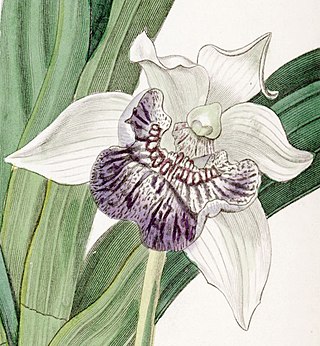
The genus Cochleanthes is made up of 4 species of orchids native to Mexico, Central America, the West Indies and South America. The name Cochleanthes refers to the shape of the flower.

Limnophila aromatica, the rice paddy herb, is a tropical flowering plant in the family Plantaginaceae. It is native to Southeast Asia, where it flourishes in hot temperatures and grows most often in watery environments, particularly in flooded rice fields. It is called ngò ôm or ngò om or ngổ in Vietnam and used as an herb and also cultivated for use as an aquarium plant. The plant was introduced to North America in the 1970s due to Vietnamese immigration following the Vietnam War. It is called "ma om" (ម្អម) in Khmer. It is used in traditional Cambodian soup dishes and Southern Vietnamese cuisine. It can grow in flooded rice paddies during wet season but it grows best on drained but still wet sandy soil of harvested rice paddies for a few months after the rainy season ended. It dies out soon after it flowers. Rural Cambodians often harvest them and put them on the roof of their houses to dry for later use.

Lycaste, abbreviated as Lyc. in horticultural trade, is a genus of orchids that contains about 30 species with egg-shaped pseudobulbs and thin, plicate (pleated) leaves.
Magnolia aromatica is a species of plant in the family Magnoliaceae. It is found in China and Vietnam. It is threatened by habitat loss.

Dryobalanops aromatica, commonly known as Borneo camphor, camphor tree, Malay camphor, or Sumatran camphor, is a species of plant in the family Dipterocarpaceae. The species name aromatica is derived from Latin and refers to the smell of the dammar (resin). This species was one of the main sources of camphor and attracted early Arab traders to Borneo, at that time being worth more than gold, and used for incense and perfumes.
ʿAlī ibn al-Ḥusayn ibn al-Wāfid al-Lakhmī, known in Latin Europe as Abenguefith, was an Andalusian Arab pharmacologist and physician from Toledo. He was the vizier of Al-Mamun of Toledo. His main work is Kitāb al-adwiya al-mufrada.

Xylopia aromatica is a species of plant in the Annonaceae family and the accepted name of Xylopia xylopioides.

Lycaste aromatica, common name the sweet scented lycaste, is a species of flowering plant in the genus Lycaste of the family Orchidaceae.

ε-Viniferin is a naturally occurring phenol, belonging to the stilbenoids family. It is a resveratrol dimer.

α-Viniferin is a stilbene trimer. It can be isolated from Caragana chamlagu and from Caragana sinica and from the stem bark of Dryobalanops aromatica. It is also present in relation to resistance to Botrytis cinerea and Plasmopara viticola in Vitis vinifera and Vitis riparia. It has been shown to inhibit acetylcholinesterase.

Diptoindonesin A is a C-glucoside of ε-viniferin isolated from the two Dipterocarpaceae Shorea seminis and Dryobalanops aromatica.

Promenaea is a genus of flowering plants from the orchid family, Orchidaceae. It contains 18 currently accepted species, all endemic to Brazil.

Rhus aromatica, the fragrant sumac, is a deciduous shrub in the family Anacardiaceae native to North America. It is found in southern Canada and nearly all of the lower 48 states except peninsular Florida.

Bergenin, alias cuscutin, is trihydroxybenzoic acid glycoside. It is the C-glycoside of 4-O-methyl gallic acid. It possesses an O-demethylated derivative called norbergenin. These are chemical compounds and drugs of Ayurveda, commonly known as Paashaanbhed. It shows a potent immunomodulatory effect.

Curcuma aromatica is a member of the genus Curcuma belonging to the family Zingiberaceae. Botanically close to Curcuma australasica, wild turmeric has been widely used as a cosmetic herbal in South Asia and nearby regions. In Tamil and Malayalam, it is known as Kasthuri Manjal, and in Telugu, bontha-pasupu (బొంతపసుపు).
Thauera aromatica is a species of bacteria. Its type strain is K 172T.
Dechloromonas aromatica is a gram negative, facultative anaerobe bacterium from the genus of Dechloromonas which was isolated of the Potomac River sludge in the mid-Atlantic coast of the United States and occurs in environment soil. Dechloromonas aromatica has the ability to degrade benzene anaerobically, reduce perchlorate and oxidize chlorobenzoate, toluene and xylene.

Zygopetalinae is an orchid subtribe in the tribe Cymbidieae with 418 species.

Ageratina aromatica, also known as lesser snakeroot and small-leaved white snakeroot, is a North American species of plants in the family Asteraceae. It is widespread and common across much of the eastern and southern United States from Louisiana to Massachusetts, as far inland as Kentucky and Ohio.
Antennaria aromatica, the scented pussytoes, is a North American species of plants in the family Asteraceae. It is native to the Rocky Mountains of Alberta, Montana, Idaho, and Wyoming. The crushed foliage has a strong scent resembling that of citronella.















